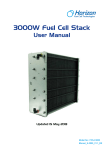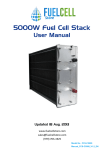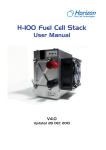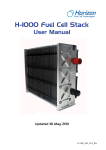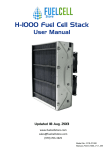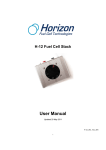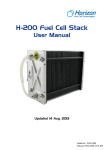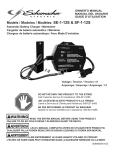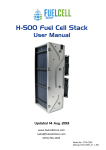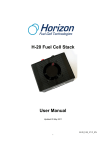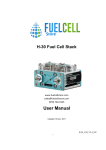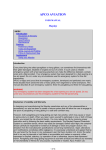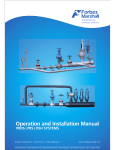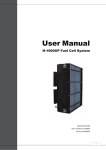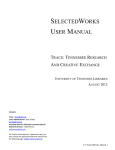Download 5000W Fuel Cell Stack
Transcript
5000W Fuel Cell Stack User Manual Updated 09 Mar. 2012 H-5000_UM_V2.7_EN Disclaimer This manual incorporates safety guidelines and recommendations. However, it is not intended to cover all situations. It is the responsibility of the customer to meet all local safety requirements and to ensure safety during operation, maintenance and storage of the H-5000 stack. Although all efforts have been made to ensure the accuracy and completeness of the information contained in this document, Horizon reserves the right to change the information at any time and assumes no liability for its accuracy. Actions that will void the fuel cell and controller warranty: ● ● ● ● ● ● ● Attempt,underanycircumstance,todisassembleorinappropriatelytamperwith the fuel cell. OperatethefuelcellwithacontrollernotdesignedandbuiltbyHorizonforthe speciicfuelcell. Operatethefuelcellwithvalvesandblowers,thatarenotprovidedbyHorizonfor thespeciiedfuelcellandcontroller. Disassemblethefuelcell. Disassemblethecontroller. Operatingthefuelcellandcontrollerthatisnotinthesetupand/orspeciiedinthe usermanualprovideforthespeciicproduct. OperatethefuelcellstackwithoutthecontrollerproducedbyHorizonorwiththe controller not produced by Horizon. Do not attempt, under any circumstance, to disassemble or inappropriately tamper with the fuel cell. There will be no returns, refunds or exchanges should disassembly or tampering occur. If you have questions or need help with regards to the fuel cell and its technology contact: [email protected] IMPORTANT In order for the warranty to come into effect the stack must be registered on the Horizon Warranty Page at: www.horizonfuelcell.com/warranty.htm H-5000 Fuel Cell Stack User Manual V2.7 Table of Contents 1. Safety.............................................................................................. 1 2. Terminology....................................................................................... 6 3. Stack and System Component Information...................................... 10 4.TechnicalSpeciications................................................................... 12 5. System Set Up.................................................................................. 13 6. Notes for the Set Up .......................................................................... 19 7.SystemSetupDiagram.................................................................... 21 8. Polarization Curves........................................................................... 22 9.OperatingInstructions......................................................................... 23 10. Storage and Re-use.......................................................................... 25 11. Troubleshooting................................................................................ 26 H-5000 Fuel Cell Stack User Manual V2.7 1. Safety Please read all instructions carefully prior to product use and keep this manual for future reference. The safety guidelines included here may not cover every situation. Use common sense. 1.1 General information For this unit to generate electrical power, a supply of hydrogen fuel is necessary. It is important for any operator to be aware of, understand, and follow all local safety requirements related to the handling of hydrogen and compressed gases. Ensure that your facility conforms to all local regulatory requirements, including building codes and recommendations. The fuel cell system has built-in safeguards and is designed to shut down automatically if any outof-range operating condition occurs. Possible situations include low cell voltage, high current, high temperature, low fuel pressure. •Donotoperatethestackonagradeofmorethan65℃. •Donotconnectordisconnectpowercableswhenthefuelcellstackisenergised. •Donotdismantlethesystem.ContactHorizonifyouhaveanyconcernsaboutoperation. 1.2 Using Hydrogen WARNING!FIREOREXPLOSION Keep all sources of ignition away from hydrogen. Thisunituseshydrogenfuel.Hydrogenisacolourless,odourlessandlammablesubstance.Itis highlycombustibleinthepresenceofoxygenandburnswithacolourlesslame. Leakinggasmaybehotandposeaburndanger.Stopthelowofgas–ifyouarenotindanger– andusewatertocoolthearea.Ifireoccurs,donotattempttoextinguishlames,allowtheireto burn out. Prevent overexposure to hydrogen. Hydrogen is non-toxic but can act as a simple asphyxiant by displacing the oxygen in the air. There are no warnings before unconsciousness results. When operating the stack in an enclosure: •Ensureventilationslotsareclearandunobstructedatalltimesduringoperation. •Operatewithinthetemperatureslimitsstatedinthemanual. •Neveroperateifanalarmconditionexists. Note: We highly recommend customer use a hydrogen sensor(not provided) to detect the hydrogen leakage. H-5000 Fuel Cell Stack User Manual V2.7 1 1.3 Handling Compressed Gas Cylinders WARNING Donothandlecompressedhydrogengascylinderswithouttrainingorexperience. •Useapressureregulatortocontrolthefuelinletpressuretothesystem. •Donotaltertheittingonaregulator.Askexperiencedpersonnelforhelp. •Donotattempttoforcegascylinderthreads. •Nevertransportagascylinderwithregulatorsattached.Ensurecylindercapsareinplace.Always use a cylinder cart with a safety strap or chain. •Secureahigh-pressurecylindertoabench,post,orixedobjecttoavoidaccidentalcontact. •AvoidunnecessarycontactwithOn/Offvalves.Theycaneasilymoveto“On”byaccident. 1.4HydrogenLeakage Hydrogen is colourless, odourless and tasteless. Hydrogen is non-toxic but can act as a simple asphyxiant by displacing the oxygen in the air. There are no warning symptoms before unconsciousness results. WARNING Inhaling hydrogen can lead to unconsciousness and asphyxiation. Hydrogen molecules are smaller thananyothergas,makinghydrogenmoredificulttocontain.Itcandiffusethroughmanymaterials consideredairtight.Fuellines,non-weldedconnections,andnon-metalsealssuchasgaskets,O-rings, pipe thread compounds and packings present potential leakage or permeation sites. Furthermore, hydrogen’s small molecule size results in high buoyancy and diffusivity, so leaked hydrogen will rise and become diluted quickly. Constant exposure to hydrogen causes hydrogen embrittlement in many materials. The mechanisms thatcausehydrogenembrittlementeffectsarenotwelldeined.Factorsknowntoinluencetherateand severity of hydrogen embrittlement include hydrogen concentration, hydrogen pressure, temperature, hydrogen purity, type of impurity, stress level, stress rate, metal composition, metal tensile strength, grain size, microstructure and heat treatment history. Moisture content in the hydrogen gas may lead to metal embrittlement through the acceleration of the formation of fatigue cracks. Hydrogen embrittlement can lead to leakage or catastrophic failures in metal and non-metallic components. As a preventative measure, the stack must be operated in a well-ventilated area in order to inhibit potential hydrogen accumulation. WARNING! Always operate the stack in a well-ventilated area and ensure that ventilation slots are unobstructed. H-5000 Fuel Cell Stack User Manual V2.7 2 1.5 Flammability and volatility Hydrogen is flammable over concentrations of 4 – 75% by volume in air, and is explosive over concentrationsof15–59%.Asaresult,evensmallleaksofhydrogenhavethepotentialtoburnor explode.Leakedhydrogencanconcentrateinanenclosedenvironment,therebyincreasingtheriskof combustion and explosion. Hydrogenlamesarepaleblueandarealmostinvisibleindaylightduetotheabsenceofsoot.Dueto its high buoyancy and diffusivity, burning hydrogen rises unlike gasoline, which spreads laterally. Alammableorexplosivehydrogenmixtureiseasilyignitedbyasparkorevenahotsurface.Theautoignition temperature of hydrogen is 500 °C (932 °F). The energy of a hydrogen gas explosion is 2.4 times that of gasoline or methane for an equal volume. Hydrogen gas explosions are therefore more destructive and carry further. WARNING! Amixtureofhydrogenandairispotentiallylammableandexplosiveandcanbeignitedbyasparkora hot surface. As in the presence of any fuel, all sources of ignition, including smoking, are not permitted in the vicinity of the stack. WARNING! Keep all sources of ignition away. Smoking is not permitted in the vicinity of the stack. 1.6OxygenDepletion Oxygen is a colourless, odourless, non-toxic and tasteless gas. Oxygen is essential for life in appropriate concentrations. Ambient air contains up to 21% oxygen. Oxygen levels below 19.5% are biologically inactive and mayactassimpleasphyxiants.Effectsofoxygendeiciencymayinclude:rapidbreathing,diminished mental alertness, impaired muscular coordination, faulty judgement, depression of all sensations, emotional instability, and fatigue. As asphyxiation progresses, nausea, vomiting, prostration, and loss of consciousness may result, eventually leading to convulsions, coma, and death. At concentrations below12%,immediateunconsciousnessmayoccurwithnopriorwarningsymptoms. WARNING! Lackofoxygencanleadtounconsciousnessandasphyxiation. As a preventative measure, the stack must be operated in a well-ventilated area in order to compensate for the oxygen used within the fuel cells. WARNING! Always operate the stack in a well-ventilated area. H-5000 Fuel Cell Stack User Manual V2.7 3 1.7 Electrical Safety WARNING! Avoidcontactwithanexposedfuelcellstack.Electricalshockcancausepersonalinjuryordeath. •Donottouchfuelcellplatesoranyelectricalcomponentsatanytime.Arunningfuelcellstackisa potential electrical hazard that can cause burns or electrical shock. •Donotwearmetallicjewellery–rings,bracelets,watchbands,ornecklaces–whenyouarecloseto an exposed fuel cell stack. •Minimisestaticdischarge.Ifpossible,groundallequipment. •Minimiseconductivity.Avoidcontactwithsurfacesthatareincontactwithwaterorgases.Donot operate or store in wet or damp conditions. •Neverusedamagedextensioncords. Thestackgeneratesupto120VDC(opencircuitvoltage).Thisvoltagedecreasesascurrentisdrawn from the stack. The stack produces 72V at maximum power. This voltage is exposed at the output power connections. These low voltages may constitute a shock hazard and can damage electronic components if shorted. Therefore, do not touch individual fuel cells, cell voltage monitoring equipment or electrical components. WARNING! Do not touch fuel cells, cell voltage monitoring equipment or electrical components. Electronic components can also be damaged as the result of static discharge. To minimise this, ground all equipment in contact with the stack. Never use damaged extension cords. Minimise conductivity by avoidingsurfacesincontactwithwater;handsandclothesmustbedry.Donotoperateorstorethe stack in wet or damp conditions. WARNING! Minimise static discharge. Ground all equipment. Residual reactants within the stack can develop a charge in a matter of minutes when turned off. A reading of zero volts across the entire stack does not guarantee that all fuel cells are uncharged. WARNING! Always assume that the fuel cell stack is charged. Jewellery (such as rings, necklaces, bracelets and watches) may concentrate an electric current when it comes into contact with charged components, orwhenashockpassesthroughthehumanbody.Accordingly,nojewelleryshouldbewornnearthe stack. WARNING! Donotwearjewellerynearthestack. No pungent odor, paint and perfume are allowed around stack. H-5000 Fuel Cell Stack User Manual V2.7 4 1.8 High Temperature The fuel cell stack is designed to operate at 65ºC. At this operating temperature, the air exhaust stream temperature can reach 55ºC and the cooling air stream can reach 17ºC above ambient conditions. These temperaturesaresuficienttocauseburnsorseverediscomfort.Accordingly,avoidcontactwiththefuel cell stack, or components that convey process or cooling air. WARNING! Avoid contact with the fuel cell stack or components that convey process or cooling air. H-5000 Fuel Cell Stack User Manual V2.7 5 2. Terminology PEM fuel cell: A PEM (Proton Exchange Membrane) fuel cell is a device that converts hydrogen and oxygen into water and electricity. Reactants: Reactant is a material used to start a chemical reaction. In the fuel cell the reactants are air and hydrogen by which the electricity will be generated. Humidiication: Humidity that the fuel cells need for running. Blower: Supply air to the fuel cells and meanwhile decrease the temperature in the stack. Purging valve: Purges out the water and air gas redundant in the fuel cells. Mass low per minute: The total amount of the hydrogen flow through the fuel cell every minute, which the hydrogen supply can be calculated. HFCT: Horizon Fuel Cell Technologies H-5000 Fuel Cell Stack User Manual V2.7 6 A B C D E G H I F A: Warning Labels B: FC+ connector C: Lable (FC+) D: FC- and Load- connector E: Lable (FC- and Load-) F: Grounding cable G: Supply valve H: Purge valve I: Controller connector plug H-5000 Fuel Cell Stack User Manual V2.7 7 A B C A: Hydrogen inlet connector B: Internal blowers C: Hydrogen outlet connector H-5000 Fuel Cell Stack User Manual V2.7 8 A I B C J D E F G H A: ON/OFF button B: SCU(short circuit units) switch C: LCD connector D: Fuel cell connect plug E: Blower power plug F: Blower signal plug G: Controller power supply DC 24V+ and DC 24vH: Connect to Load+ I: Connect to FC+ J: Connect to FC- H-5000 Fuel Cell Stack User Manual V2.7 9 3. Stack and System Component Information 1. Stack Is made up of plate-like cells with air channels to allow the flow of air across the membrane. The membrane facilitates the flow of Hydrogen creating the release of electrons. Electrically conductive separator plates between each pair of cells enable the flow of electrons. The stack aspect is that they are all placed on top of each other and held together by epoxy endplates. 2. H2 Supply and purging valves The supply valve controls the H2 input. When the controller turns on, also the H2 supply valve does. When system turns off, it is in the off position for preventing hydrogen leakage. The purging valve purges out the water and air gas redundant in the fuel cells. 3. Short Circuit Unit The short circuit unit can be turned on or off depending on what application the stack is to be used in. When the short circuit unit turns on, it can enhance performance of the stack in applications where the stack is turned off for prolonged periods. 4. On/Off Switch It is the switch of the controller. Hold it for 2 seconds for either on or off. 5. Internal blowers Supply air to the fuel cells and meanwhile decrease the temperature in the stack. 6. LCD Show the Current and Voltage of the stack. H-5000 Fuel Cell Stack User Manual V2.7 10 7. Controller It controls the stack temperature, blowers, hydrogen input, purging and short circuiting of the stack. 8. Hydrogen Output Hydrogen output: connect the tube shown in 11 below. 9. Hydrogen Input Hydrogen input: connect the tube shown in 11 below with the hydrogen pressure between 0.45-0.55Bar. 10. Fuel cell +/Fuel cell-&Load- Connectors FC+ of the controller is connected to the fuel cell positive pole. FC- of the controller is connected to the fuel cell negative pole. 11. Tube for H2 Input and Output The tube with 6mm outer diameter and 3mm inner diameter is connected to the H2 IN as in 9 above and to the input valve of the hydrogen source. H2 output tube with 4mm outer diameter and 2mm inner diameter is connected to the purging valve on one end and the H2 OUTtheother. 12. Grounding cable Make stack grounded for safety (already connected on the stack). 13 . Fittings For connecting the load. H-5000 Fuel Cell Stack User Manual V2.7 11 4. Technical Speciications Control electronics included: Type of fuel cell Number of cells Rated Power Performance H2 Supply valve voltage Purging valve voltage Blower voltage Reactants External temperature Max stack temperature H2 Pressure Hydrogen purity Humidification Cooling Weight (with fan & casing) Controller Dimension Flow rate at max output* Start up time Efficiency of stack Low voltage shut down Over current shut down Over temperature shut down External power supply** PEM 120 5000W 72V @ 70A 12V 12V 24V Hydrogen and Air 5 to 30ºC 65ºC 0.45-0.55bar ≧99.995﹪ dry H2 self-humidified Air (integrated cooling fan) 30000 grams(±200grams) 2500 grams(±100grams) 40.4cm x 21.2 cm x 69.2cm 70 l/min ≦30S at ambient temperature 40% @ 72V 60V 90A 65℃ 24V(±1V), 8A~12A * The low rate may change with the power output ** System electronics need external power supply *** The Speciication is subject to change without notice. H-5000 Fuel Cell Stack User Manual V2.7 12 5. System Set-Up PLEASE READ CAREFULLY BEFORE STARTING WARNINGS: 1. The tube between the hydrogen pressure regulator and the fuel cell gas input is required to be less than 30cm. The inner diameter of the hydrogen supply tube is required to be more than 3mm. The input pressure to the stack is required to be 0.45-0.55Bar . 2. Disconnect the hydrogen tube from the hydrogen inlets immediately after the fuel cell stack is shut down. Since hydrogen gas can leak into the fuel cell and destroy the stack. 3. The stack must be standing on the clear plastic feet. 4. Make sure the dry Hydrogen gas to be used must be ≥99.995% purity. 5. Make sure you have purged the water out of the stack as much as possible if you injected water into the stack. Using the fuel cell stack with too much water inside can irreparably damage it! 6. Do not vibrate the stack when it is in operation. 7. Keep the stack in ventilation when it is in operation. 8. The external power voltage is required to be 24V(±1V). 9. Keep the SCU always on. Only when it causes your load operating in dificulty, turn off the SCU. 10. The tube between stack output and purging valve is required to be less than 20cm. The tube connected to the purging valve output is required to be less than 30cm. The inner diameter of the tube is required to be more than 2mm. STEP 1: Connect the connectors of the controller to the stack (1A), the temperature sensor, the hydrogen supplyvalveandthepurgevalveundercontrol.Theinishedconnectionisshownin1B. Connect the stack blower power cable to the controller blower power cable (see picture 1C). Connectthestackblowersignalcabletothecontrollerblowersignalcable(seepicture1D&1E). 1B 1A 1 2 2 3 43 4 5 5 6 7 86 Controller connector Wire colours Connector pin # Blue #1 Yellow #2 Red #3 11 7 Periferals controlled Hydrogen purge valve Hydrogen supply valve Temperature Sensor 12 8 Blowers power connector Wire colours Connector pin # Red Black #7 #8 Periferals controlled Blowers power 1C H-5000 Fuel Cell Stack User Manual V2.7 13 1E 1D 9 9 10 10 Blowers signal connector Wire colours Connector pin # Yellow Black #9 #10 Periferals controlled Blowers signal STEP 2: Connect controller "FC+" to the stack "FC+" and controller "FC-" to stack "FC-&Load-".The inishedconnectionisshownin2D. 2A 2B 2C 2D H-5000 Fuel Cell Stack User Manual V2.7 14 STEP 3: Connectthecontrollertoastablepowersupplythroughthe“DC24V”connectors(3A),andthe voltage of the power supply should be between 24V and 25V. 3A STEP 4: LaytheHydrogensupplyvalveandthepurgevalveatthebackofblowerincaseofthedamage caused by the Hydrogen purge (see picture 4A). STEP 5: KeeptheSCU(ShortCircuitUnit)switchONat“-”forusualuse. Warning: Some home appliances may not be suitable for this activation process. It may cause damaging. You can shut off the short circuit by switching it to "O", but it will cause at least 20% performance loss. 4A H-5000 Fuel Cell Stack User Manual V2.7 5A 15 STEP 6: Connect the Hydrogen supply valve to the stack. The Hydrogen supply valve will prevent damage from the Hydrogen while the stack is off. Pay attention to the direction of the connection of the Hydrogen supply valve. The letter "P" refers to the hydrogen input and "A" refers to hydrogen output. Theinishedconnectionisshownin6F. WARNING: The tube between the hydrogen pressure regulator and the fuel cell gas input is required to be less than 30cm.The inner diameter of the tube is required to be more than 3mm. The input pressure to the stack is required to be 0.45-0.55Bar. 6A 6B 6C 6D 6E 6F H-5000 Fuel Cell Stack User Manual V2.7 16 STEP 7: Connect the stack to the purge valve. The letter "P" refers to the hydrogen input and "A" refers to hydrogen output. Theinishedconnectionisshownin7E.Keeptheoutputofthepurge valve to a place away from the stack in case of the damage caused by purged hydrogen. See the pictures below. 7A 7B 7C 7D 7E Note: The tube between stack output and purging valve is required to be less than 20cm. The tube connected to the purging valve output is required to be less than 30cm. The inner diameter of the tube is required to be more than 2mm. H-5000 Fuel Cell Stack User Manual V2.7 17 STEP 8: Check all the connection first and connect the load to the system as shown in 8A. Load + is connectedto“load+”ofthecontroller,load–connectedtothe“FC-andload–”ofthestack. 8A STEP 9: Connect LCD to the controller as shown in 9A. Provide hydrogen and turn on external power supply,thenpresstheON/OFF(9B)switchformorethan2secondstostartthesystem.Ifyouwant toswitchoffthesystem,presstheON/OFF(9B)switchfor2seconds. 9B 9A STEP 10: Check the following steps before starting the system: 1. The connection between hydrogen pressure and hydrogen supply valve. 2. The connection between hydrogen supply valve and the stack input. 3. The connection between stack output and purging valve. 4. The output tube of the purging valve is kept away from the stack. 5. The connections between stack and controller. 6. The input hydrogen pressure is 0.45-0.55Bar. 7. The external power supply is 24V(±1V), 8A-12A. 8. The load is below 5000W. The System is now setup and ready to be used. H-5000 Fuel Cell Stack User Manual V2.7 18 6. Notes for the set-up Note: The pictures below are only for reference. Stack should be placed like this position. Stand on the plastic feet. The voltage of external power supply is 24V(±1V) for 5000W, the current range is different based on the different stack. The tube is required to be less than 20cm between stack output and purging valve. The tube connected to the purging valve output is required to be less than 30cm. The inner diameter of the tube is required to be more than 2mm. Warning: The tube between the hydrogen pressure regulator and the fuel cell gas input is required to be less than 30cm. The pressure of the hydrogen is between 0.45--0.55Bar. The load connecter, load+, is connected to the "load +"in the controller. The load- is connected to "FC- & Load-" in the stack. H-5000 Fuel Cell Stack User Manual V2.7 19 The outlet of the purge valve should be far away from the stack. Don't let the hydrogen from purge valve low back to the stack, otherwise it would damage the stack. Note: The tube between stack output and purging valve is required to be less than 20cm. The tube connected to the purging valve output is required to be less than 30cm. The inner diameter of the tube is required to be more than 2mm. H-5000 Fuel Cell Stack User Manual V2.7 20 7. System setup diagram SCU: Short Circuit Unit GND:Grounding H-5000 Fuel Cell Stack User Manual V2.7 21 8. Polarization curves Performance characteristics of the stack are presented. All performance data is given forbaselineoperatingconditions,deinedatsea-levelandroomambienttemperature. V H5000 U-I Curve 120 100 80 60 40 20 A 0 0 10 20 30 40 50 60 70 80 90 H5000 U-I Curve ml H5000 H2 flow 80000 70000 60000 50000 40000 30000 20000 10000 W 0 0 1000 2000 3000 4000 5000 6000 H5000 H2 f low W H5000 P-I Curve 6000 5000 4000 3000 2000 1000 A 0 0 10 20 30 40 50 60 70 80 90 H5000 P-I Curve H-5000 Fuel Cell Stack User Manual V2.7 22 9. Operating instructions STARTUP PROCEDURE Make sure both the stack and the ambient temperature are less than 45℃.Otherwisethesystem will not start up successfully. HoldtheON/OFFbuttondownfor2secondsandthenreleaseittostartthesystem;youwillhear one beep, which means the system has started. RUNNING PROCEDURE After system has started, depending on your setup and application you can change your load to get thepoweryouneedwithinthespeciiedpowerrangeforthisfuelcell. Don’tconnectupaloadthatwilldemandpowermorethan5000Wwhichcanpermanentlydamage the fuel cell. Duringtheoperation,monitortheHydrogenlowandpressuretoconsistentlysupplyhydrogenat 0.45-0.55Bar. Monitor the voltage of the external power is 24V(±1V). Directtheoutlettubingofthepurgevalveawaythefuelcell.Donotletthepurgedhydrogengo back towards the fuel cell stack, it will damage the fuel cell. Pay attention to the purge, take care of the performance during the purge, If after each purge, the performanceisincreasedabout10%,itmeansyouneedtoincreasethepressureofhydrogena smallamount.Thefuelcellisloodingandsoyouneedtousethepressuretopushextrawaterout. Duringtheoperation,youneedtokeeptheSCUONat"-",itwillconditionthefuelcellforrated power and keep it conditioned for long performance lifetimes. ●Shortcircuitwillhappenevery10secondsandlastfor100mseverytime. ●Iftheloaddoesnotoperatewellwiththeshortcircuitonwerecommendthatyourunthe fuel cell for 10 minutes prior to switching the load on. ●Therewillbeaslightdecreaseinthepowerprovidedtotheloadwiththeshortcircuitoff. H-5000 Fuel Cell Stack User Manual V2.7 23 SHUTDOWN PROCEDURE To shut down the fuel cell system down, please follow these steps: 1. Turn off the load. 2.HoldtheON/OFFbuttondownfor2secondstostopthesystem,youwillhearonelongbeep, which means the system is shutting down. Note: When you turn off the on/off switch connected to the control box at the temperature of the fuel cell stack higher than 45˚C the stack will not stop working immediately. Only when the stack temperature goes down below 45˚C, the whole system will stop operation in order to protect the stack. So in order to make it work well, the fuel cell stack must be maintained lower than 45˚C before operate the on/off switch. 3. Turn the hydrogen supply off. 4.Disconnectthehydrogensupplytubefromthehydrogeninletsasshowninthepicturebelow. WARNING: Disconnect the hydrogen tube from the hydrogen inlets immediately after the fuel cell stack is shut down. Since hydrogen gas can leak into the fuel cell and destroy the stack. If the fuel cell is not in use, please follow these inal steps. Disconnecttheexternalpowersupplyfromthecontroller. Completely disconnect the fuel cell system from the load. Completely disconnect the fuel cell system from the controller. Letthefuelcellcooldownbeforeplacingitintoanairtightcontainer.Thiswillhelpmaintainingits performance particularly during long periods of storage. H-5000 Fuel Cell Stack User Manual V2.7 24 10. Storage and Re-Use Wheninishedoperatingthestack,placeitinanenclosedareaforstoragetokeepthestackfromgetting too dry. The stack should be stored at room temperature. Ifthestackisun-usedforalongperiodoftime(morethan4weeks)andit'sperformancegoesdown50% to the rated power at 72V after 30 minutes operation, we recommend do the following steps. Note: Generally, injecting water into the stack it is not recommended. Only if the performance of the stack decreases 50% is it recommended to inject water into the stack to activate the stack before operation. Rejuvenate by injecting water into the stack: 1. Usea3portsconnectortoconnect3shorttubes.Connect2tubestothe“H2input”ports. 2. Fillasyringe(notprovided)withdistilledorpuriiedwater(seepictureA).Makesurethereisnoair in the syringe. And then connect it to the remaining tube on the 3 ports connector. 3. Injectdistilledorpuriiedwaterintothestackuntilyouseewatercomingoutofthe“H2output” ports. Keep the water inside the stack for about 2 minutes. Now disconnect the syringe with the tube. 4. Purged water out of the stack. Connect the H2 supply (0.45-0.55Bar) to the stack through the tube without a load attached (see pictureB),topurgewateroutofthestackasmuchaspossible(i.e.lettinghydrogenlowthrough the stack to remove water and other contaminants) (see picture C). Using the fuel cell stack with too much water inside can irreparably damage it! 0.45-0.55Bar A B WARNING: C 1. Make sure the hydrogen supply pressure is 0.45-0.55Bar. 2. Please make sure you have purged the water out of the stack as much as possible before use if you injected water into the stack. Using the fuel cell stack with too much water inside can irreparably damage it! 3. The tube between the hydrogen pressure regulator and the fuel cell gas input is required to be less than 30cm. H-5000 Fuel Cell Stack User Manual V2.7 25 11. Trouble Shooting If the stack is not used for a long time (months), it will take a little time to get the rated power, it needs 5-30 minutes. Only it's performance goes down 50% to the rated power at 72V after 30 minutes operation we recommend to inject water into the stack to activate the stack before operation. Please see the detailed information in Storage and Re-Use. If the system shuts down by itself check the following details: 1. MakesureyouhaveconnectedallwiresaccordingtotheSystemSetupDiagram. 2. Make sure the external power supply is 24V(±1V), 8A-12A. 3. Make sure the input hydrogen pressure is 0.45-0.55Bar. 4. Make sure the load is below 5000W, because the controller will protect the stack from drawing too much current. 5. Check whether the fuel cell temperature is below 65oC, the system will shut off if it is above 65oC. Do not attempt, under any circumstance, to disassemble or inappropriately tamper with the fuel cell. There will be no returns, refunds or exchanges should disassembly or tampering occur. If you have questions or need help with regards to the fuel cell and its technology contact: [email protected] H-5000 Fuel Cell Stack User Manual V2.7 26





























